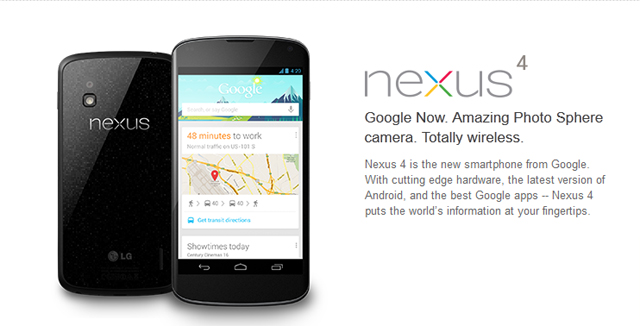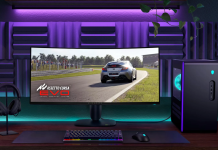I was in Sydney yesterday to take advantage of an invitation from LG Australia. I met with Brad Reed, Senior Marketing Manager – Mobile Communications, Content and Applications and Josh Corin, Local Product Manager – Mobile Communications. We spoke for some time about some upcoming products – the Nexus 4, Optimus G, and the L-Series (which is currently on-sale).
The interview included a chance to spend some quality time with the Nexus 4.
LG has spent a while off the beaten path – so to speak – with their phone offerings. Recently however, the company has made an effort to offer a more cohesive and appealing brand to consumers. This renewed effort started with the L-Series and looks set to continue with the Optimus G, expected in Australia in early 2013.
Nexus 4
In terms of feel, the Nexus 4 is a lovely piece of equipment that sits very comfortably in the hand – mainly thanks to the soft-touch plastic that surrounds the device. Whilst the Nexus 4 is a little heavier than the Galaxy Nexus (4 grams), it also feels like it has a better build quality.
Google were heavily involved in the design process of the phone, while the phone underneath is essentially the Optimus G. Some LG design decisions remain as a result of this – such as the location of the headphone jack at the top of the device. It turns out, Google also chose the crystal reflective pattern that adorns the back of the device. For those worried that the pattern you’ve seen is a bit over the top, you really have to try and position the device in the light correctly to actually see it.
The feel of better build quality is mostly due to the usage of Corning Gorilla Glass 2 on the front and back of the device. This is definitely a worry for some, however there are some very good videos out there displaying the strength of Gorilla Glass 2. LG seems pretty confident in the strength of the glass.
Speaking of components and build quality, LG told us that they have historically provided high quality components for other manufacturers which has won those vendors kudos from the industry while LG’s mobile products made do with lower quality part. That strategy has now changed – LG Mobile will now be presenting their best technology in their own mobile devices first – this will include their batteries and screens.
The display on the Nexus 4 is stunning – a 4.7″ 1280×768 True HD IPS Plus display, supported by Zerogap Touch Technology. I have been using the Galaxy Nexus pentile Super AMOLED display for a fair while now, and there is a welcome change to viewing a screen with actual white rather than a bluish-grey, as well as getting the true deep blacks that I’m already used to. Frankly, short of the Super LCD 2 screen in the HTC One X I’ve personally not seen a better screen, and even then a comparison between both the screens is going to be a very close call.
The Zerogap Touch Technology strips away some of the layers of lamination commonly used in screens, as well as incorporating the touch sensor directly into the glass – it gives you the effect of being directly in contact with the information on the screen, and immerses you within the screen. It’s very, very nice to use. This is also helped along by the use of the Snapdragon S4 Pro CPU and the Adreno 320 GPU.
LG is first to market with a device using the Snapdragon S4 Pro SOC, and I can tell you that it’s something truly stunning to use. The term ‘Greased Lightning’ comes to mind. Together with 2GB of RAM, the Nexus 4 – and also the Optimus G – are able to handle some serious work with zero lag. Applications jump open immediately, and videos play in full HD with no issues whatsoever.
Battery-wise, LG delivers some industry leading battery technology in both the Nexus 4 and the Optimus G. The 2100mAh battery offers a more densely packed battery, allowing them to go through more charging cycles than other batteries. LG says that the battery technology would offer around 800 cycles compared to 500 in batteries from other manufacturers. This will have to be tested when we get some time with review units.
In terms of network connectivity, while much has been made of the lack of LTE, the Nexus 4 has 42mpbs Dual Channel HSPA. On DC-HSPA enabled networks such as Telstra, you’ll see some truly impressive speeds. The lack of LTE is going to come down to a personal choice – much of Australia still has no access to LTE, and therefore this will not affect the decision process for many consumers. If you’re after LTE, then the Optimus G is due out next year with almost identical hardware.
The 8 MP camera in the Nexus 4 is a marked improvement over the Galaxy Nexus, although this isn’t hard to do. LG seems to have taken the ball and run with it, delivering a truly brilliant photo from the included camera sensor. I’m going to have to do a lot of comparison shots with the camera, but I personally have nothing detrimental to say about it at this stage.
Accessories
Previous Nexus devices have seen an absolute dearth of accessories at release. Screen protectors, docks, cases, and batteries have slowly dribbled out over the life of the device. Unfortunately this trend seems set to continue, with no information regarding accessories announced thus far. LG advised that the accessory side of thing is up to Google, LG is functioning purely as an OEM in this case, meaning they’ll build accessories according to what Google ask them to build. Sales of any accessories will be made through Google.
This includes the wireless charging orb that was shown off when The Verge did their initial video on the Nexus 4. The Nexus 4 uses QI inductive charging which is yet to be released here. Energizer Australia has no plans to release their Qi-Enabled 3 Position Inductive Charger, although LG did advise that the Lumia 920 charging mat will work, so there are options.
Dan Morill from Google also mentioned a bumper accessory in a Google+ post, which leads me to believe that there are accessories coming. How soon, how much, and exactly what accessories are questions we’ll have to wait for Google to answer.
Android 4.2
In terms of software, the final Android 4.2 build is still not complete but many of the features we’ve heard about are already in full effect:
Gesture Type keyboard – The new keyboard is very fast, functional and is brilliant in effect, I had deliberately avoided using the leaked APKs to try and experience it properly on the Nexus 4, and it definitely adds value to Android.
Quick settings – I found the Quick Settings a little awkward in terms of remembering to use the two-finger gesture to initiate them, but I believe this will become easier to use as you use it more often.
Photo Sphere – While Photo Sphere works as advertised, it looks as though it could take a fair while to stitch an image together, and movement within the shot whilst building your Photo Sphere could certainly be a little bit on the rough side. I believe this feature could be a winner, but it will need a lot more use to make that sort of determination.
Miracast – If you’ve played with AirPlay on Apple equipment, then you know what this is. If you haven’t, you’re in for a treat. Miracast is the dual-display technology that is being offered across the industry to offer an alternative to AirPlay. Effectively it uses a Wi-Fi connection to mirror your device display to a TV and it works brilliantly on the Nexus 4, however its downfall is its ‘newness’ – there is a lack of TV’s/Dongles/boxes to allow you to use it in your own home. LG had a dongle they were using to demo the function, however they wouldn’t let me steal it.
I didn’t get to see the DayDream function in use but I look forward to playing with it when it arrives.
Impressive
Overall, I left my meeting with LG Impressed – yes, with a capital I. They’ve shown some amazing forethought in the design process with both the Nexus 4 and the Optimus G (which we will hear more about in the coming months).
At $349 for 8GB or $399 for a 16GB Nexus 4, a purchase is to me a no-brainer. While the lack of LTE and microSD will be a turn off for some, at these prices I’ll certainly be ‘lining up’ to place my order for one next week on the 13th of November when orders go live in the Google Play Store.
Will you be buying the Nexus 4, or are you on the fence? Let us know in the comments!






